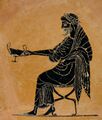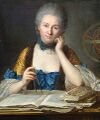Template:Selected anniversaries/December 17: Difference between revisions
No edit summary |
No edit summary |
||
| (6 intermediate revisions by the same user not shown) | |||
| Line 26: | Line 26: | ||
||1833: Kaspar Hauser dies ... alleged feral child. | ||1833: Kaspar Hauser dies ... alleged feral child. | ||
||1835: Felice Casorati born . | File:Felice Casorati.jpg|link=Felice Casorati (nonfiction)|1835: [[Felice Casorati (nonfiction)|Felice Casorati]] born. Casorati will contribute the Casorati–Weierstrass theorem in complex analysis. | ||
File:Marius Sophus Lie.jpg|link=Marius Sophus Lie (nonfiction)|1842: Mathematician and academic [[Marius Sophus Lie (nonfiction)|Marius Sophus Lie]] born. He will largely create the theory of continuous symmetry and apply it to the study of geometry and differential equations. | File:Marius Sophus Lie.jpg|link=Marius Sophus Lie (nonfiction)|1842: Mathematician and academic [[Marius Sophus Lie (nonfiction)|Marius Sophus Lie]] born. He will largely create the theory of continuous symmetry and apply it to the study of geometry and differential equations. | ||
||1853: Pierre Paul Émile Roux born ... physician, bacteriologist, and immunologist ... one of the closest collaborators of Louis Pasteur (1822–1895), a co-founder of the Pasteur Institute, and responsible for the institute's production of the anti-diphtheria serum, the first effective therapy for this disease. Pic. | |||
||1861: Arthur Edwin Kennelly born ... electrical engineer. | ||1861: Arthur Edwin Kennelly born ... electrical engineer. Pic. | ||
||1862: American Civil War: General Ulysses S. Grant issues General Order No. 11, expelling Jews from parts of Tennessee, Mississippi, and Kentucky. | ||1862: American Civil War: General Ulysses S. Grant issues General Order No. 11, expelling Jews from parts of Tennessee, Mississippi, and Kentucky. | ||
| Line 39: | Line 39: | ||
||1892: George Brayton dies ... mechanical engineer who lived with his family in Boston and who is noted for introducing the constant pressure engine that is the basis for the gas turbine, and which is now referred to as the Brayton cycle. Pic. | ||1892: George Brayton dies ... mechanical engineer who lived with his family in Boston and who is noted for introducing the constant pressure engine that is the basis for the gas turbine, and which is now referred to as the Brayton cycle. Pic. | ||
||1896: Joseph von Gerlach dies ... professor of anatomy and a pioneer of histological staining and anatomical micrography. In 1858 Gerlach introduced carmine mixed with gelatin as a histological stain. Along with Camillo Golgi, he was a major proponent of the reticular theory that the brain's nervous system consisted of processes of contiguous cells fused to create a massive meshed network. Pic. | |||
||1896: Pittsburgh, Pennsylvania's Schenley Park Casino, which was the first multi-purpose arena with the technology to create an artificial ice surface in North America, is destroyed in a fire. | ||1896: Pittsburgh, Pennsylvania's Schenley Park Casino, which was the first multi-purpose arena with the technology to create an artificial ice surface in North America, is destroyed in a fire. | ||
| Line 54: | Line 56: | ||
||1912: Fritz Klingenberg born ... German officer in the Waffen-SS who served with the SS Division Das Reich and was a commander of the SS Division Götz von Berlichingen. He was best known for his role in the capture of the Yugoslavian capital, Belgrade with just 6 men, for which he was awarded the Knight's Cross of the Iron Cross. Pic. | ||1912: Fritz Klingenberg born ... German officer in the Waffen-SS who served with the SS Division Das Reich and was a commander of the SS Division Götz von Berlichingen. He was best known for his role in the capture of the Yugoslavian capital, Belgrade with just 6 men, for which he was awarded the Knight's Cross of the Iron Cross. Pic. | ||
||1916: Martin Arthur Pomerantz born ... physicist who served as Director of the Bartol Research Institute and who had been a leader in developing Antarctic astronomy. Pic search | ||1916: Martin Arthur Pomerantz born ... physicist who served as Director of the Bartol Research Institute and who had been a leader in developing Antarctic astronomy. Pic search. | ||
||1920: Kenneth E. Iverson born ... computer scientist, developed the APL programming language. Pic. | ||1920: Kenneth E. Iverson born ... computer scientist, developed the APL programming language. Pic. | ||
| Line 72: | Line 74: | ||
||1961: Niterói circus fire: Fire breaks out during a performance by the Gran Circus Norte-Americano in the city of Niterói, Rio de Janeiro, Brazil, killing more than 500. | ||1961: Niterói circus fire: Fire breaks out during a performance by the Gran Circus Norte-Americano in the city of Niterói, Rio de Janeiro, Brazil, killing more than 500. | ||
||1964: Victor Francis Hess dies ... physicist and academic, Nobel Prize laureate, discovered cosmic rays. Pic. | |||
||1964: Victor Francis Hess dies ... physicist and academic, Nobel Prize laureate. | |||
||1964: Jurjen Ferdinand Koksma dies ... mathematician who specialized in analytic number theory. Pic: book cover. | ||1964: Jurjen Ferdinand Koksma dies ... mathematician who specialized in analytic number theory. Pic: book cover. | ||
||1969 – Project Blue Book: The United States Air Force closes its study of UFOs. | ||1969 – Project Blue Book: The United States Air Force closes its study of UFOs. | ||
||1977: U.S. Army combat historian Samuel Lyman Atwood Marshall dies. Known professionally as S. L. A. Marshall, and nicknamed "Slam" (the combination of all four of his initials), he authored some 30 books about warfare, including ''Pork Chop Hill: The American Fighting Man in Action'', which was made into a film of the same name. However, his legacy is mired in scandal, as he lied about his involvement in the primary events he wrote about. Pic. | |||
||1999: Jürgen Kurt Moser dies ... mathematician, honored for work spanning over 4 decades, including Hamiltonian dynamical systems and partial differential equations. Pic. | ||1999: Jürgen Kurt Moser dies ... mathematician, honored for work spanning over 4 decades, including Hamiltonian dynamical systems and partial differential equations. Pic. | ||
| Line 84: | Line 86: | ||
||2003: SpaceShipOne, piloted by Brian Binnie, makes its first powered and first supersonic flight. | ||2003: SpaceShipOne, piloted by Brian Binnie, makes its first powered and first supersonic flight. | ||
||2014: Dieter Grau dies ... scientist and engineer. | ||2014: Dieter Grau dies ... scientist and engineer. Peenemunde. Pic. | ||
||2015: Osamu Hayaishi dies ... biochemist and academic. Pic search. | |||
</gallery> | </gallery> | ||
Latest revision as of 17:20, 7 February 2022
498 BC: Dionysus gives speech which anticipates the coming of Saturnalia.
497 BC: The first Saturnalia festival celebrated in ancient Rome.
1706: Mathematician and physicist Émilie du Châtelet born. She will translate and comment upon on Isaac Newton's Principia Mathematica.
1835: Felice Casorati born. Casorati will contribute the Casorati–Weierstrass theorem in complex analysis.
1842: Mathematician and academic Marius Sophus Lie born. He will largely create the theory of continuous symmetry and apply it to the study of geometry and differential equations.
1900: Mathematician and academic Mary Cartwright born. She will do pioneering work in what will later be called chaos theory.
1907: Lord Kelvin dies. He did much to unify the emerging discipline of physics in its modern form.
1938: Physicist Otto Hahn discovers the nuclear fission of the heavy element uranium, the scientific and technological basis of nuclear energy.







